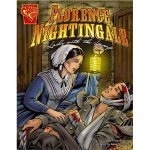Florence used statistics to make her case…
Listen to my BBC radio chat with Malcolm. We discuss Florence Nightingale starting at 6 minutes and 45 seconds in this clip:
Florence Nightingale (1820-1910) might have been a lady with a lamp, and she might have been a nurse, but I want to tell you that she was a scientist and a mathematician too! I’ll get to that in a bit.
Born into a rich English family living in Tuscany (it was the place to go then too I suppose), Florence was pre-destined to be a young lady of leisure and to do what all in her position were expected to do: marry well and have babies. She went for option B – eschewed the pile of 20 mattresses and instead spent her life caring for those in need. Fortunately, Florence’s father saw that an education was a requirement for a well-to-do young lady and he personally tutored her in mathematics. ‘What-everrr… when am I ever going to use this in real life?’
Uh, no, Florence didn’t say that.
Rather, after being ‘called by God’ in 1837, i.e. age 17, she announced her decision to go into nursing. Unbelievably, this decision caused much consternation for her mother but she soldiered on. It was during 1854 that she and a group of 38 women who had trained under her were despatched to the Crimean War (hope they had their satnavs working – where is Crimea?) to attend to injured British soldiers.
The Crimean War was, Florence wrote, ‘calamity unparalleled in the history of calamity’. To her it was obvious that the quality of care being offered to the wounded was sorely lacking and she set about revolutionizing the way that nursing is practised – right up until today.
From the writing of Ed Hird –
No operating tables. No medical supplies. No furniture. The lack of beds, for example, meant that the best the wounded soldiers could hope for was to be laid on the floor wrapped in a blanket. Rats ran amongst the dying. On occasion, even dead bodies were forgotten about and left to rot. There had been no washing of linen – and every shirt was crawling with vermin. Florence ordered boilers – and boilers were installed. Florence was able to demonstrate that for every soldier killed in battle in the Crimean War, seven died of infections and preventable disease.
Florence’s contention was that cleanliness and good nutrition would go a long way to increasing survivorship – and she deduced this without really knowing about germs because people weren’t really yet studying them at that time.
But how did Florence make a compelling argument to the officials back in Britain about these terrible conditions? She fell back on her early learning, realizing that statistics and data presented as pages of numbers were boring and not persuasive to politicians. Instead, she collected numbers of the wounded who benefited from her new nursing ideas and devised a persuasive way to present them – The pie chart.
Don’t let me hear you groaning about the pie chart – what a wonderful concept. It
can encapsulate pages of numbers and distill the outcome of an experiment so that a casual observer immediately sees what is important. Pie charts weren’t invented by Florence but she is the one most responsible for putting them to good use. In fact, she invented a type of pie chart known as a polar area diagram, or by some as a Nightingale rose diagram. Politicians back in England took one look at her data presented in such a diagram and immediately saw the benefit of doing things Florence’s way. She was given resources and staff to clean war hospitals and to bring standards of care up to reasonable levels. What came to pass was that far fewer men died as a consequence of injuries and Florence became famous the world over for her new nursing system.

One of Florence’s actual Nightingale rose diagrams illustrating the causes of mortality during the Crimean war.
In 1860, Florence established the Nightingale Training School – not for training nightingales – at St. Thomas’ Hospital in London. The school still exists and is called the Florence Nightingale School of Nursing and Midwifery.
Florence was an author, too (didn’t she sleep?). She penned Notes on Nursing in 1859 and is widely acknowledged as ‘the founder of modern nursing.’
Tireless effort and compassion helped Florence Nightingale change the world but let us not forget that she got where she did – in part – by being a mathematician and scientist!



